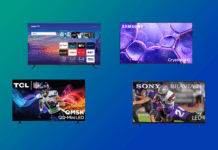
I was fortunate to be one of the first people to test out the new Android TVs that Sony is about to launch. Android media streaming boxes came out last year, but these are the first TVs that I have seen with an Android platform built right in. The Android operating system has become a well-developed platform for Smartphones and Tablets, but it still needs a bit more development to become a solid TV platform. With the availability of thousands of Android apps and the ability to seamlessly integrate with Android mobile devices, Android TV has plenty of potential.
Sony is bringing out a number of new TVs with the Android platform, both HD and 4K models. I was able to check out a few of their new 4K models, which included a Sony 49″ Bravia X830C, a Sony Bravia X850C, and a 65” Bravia X930C. The only Android HD model Sony has so far is the Bravia W800C, which I saw in a 50” version, but it also comes in 60”, 65”, and 75” sizes. They are all attractive sets with great features but this review is intended to focus on what the new Android TV platform looks like.
Android TV Setup
I have set up a lot of new TVs over the years, but I have to say the Android set up was as simple as any that I have done before. In fact, it used my Android phone in a way that was pretty slick. The first step is connecting the TV to my wireless network through a couple of simple prompts. Then the TV displayed a URL to punch into my phone’s web browser. Once I typed that in, the TV immediately gave me a PIN # to put into my phone. I was then instantly connected and automatically logged into all my Google accounts on the TV.
The TV also lead me through their Terms of Service and Privacy Policy, which is the typical legal-eze that I had to agree to. I then got prompted to pick my TV source (cable, satellite, etc.). It then let me know that the software needed updating, which I immediately proceeded to do. The update must have been fairly significant as it took at least 15 to 20 minutes to complete. Either that or my Internet connection happened to be slow at the time.
 Android TV Interface
Android TV Interface
The Android TV interface is very streamlined and straightforward to use. On the home screen, everything is organized in rows. The rows consist of the Android TV categories and include recommended content, featured apps, inputs, apps, and games, etc. I was able to easily scroll from one row to the next and then scroll across a row. What I wasn’t sure of is how Android decides what content to recommend in the “recommended content” tier. The featured apps row also wasn’t clear, although I guess they are the apps that they are trying to promote.
Once you find the app that you are looking for, opening it will then potentially provide another layer to select from. For instance, I opened up the Sony Select app, and it had another menu and rows of apps to choose from. So the interface is that simple! Find the row of content that you want, scroll through it to find the app you are looking for and then open it for more content.
 Android Features
Android Features
The feature I immediately really liked is the Android TV voice search capability. I have both an Android phone so it is just like the Google voice search, except it searches only the content available on the TV rather than doing a broader Internet search. For iPhone users this is Google’s version of Siri. The reason I liked it is because searching with many Smart TVs requires a tedious process of using the remote control to hunt and peck each letter to spell out your search. The Android voice search made it dead easy and quick. More TVs are coming out with voice search capability but the Android one was fast and worked extremely well.
Another feature that was a little unique with the Android TV is that it has a free app called “TV SideView,” available on both the Android and IOS platform. This app converts your phone or tablet into a remote control that will do much more. For instance I put in my postal code and then selected my cable provider and the app then provides a full TV guide. It makes recommendations for you based on what you have been viewing, and has a variety of other content available like YouTube, Cackle, etc. The app is not a generic Android app but one that Sony has adapted to work with their Android TV.
 Another feature I liked was the simplicity of screen mirroring. Screen mirroring is a common feature with many Smart TVs and a lot of them also make it pretty easy to use. Android TV has an app on the menu to do this. Opening up the app and it simply gave me the instructions on where to find the screen-mirroring setting on my Android phone. I went there and the found of the Sony TV model was displayed, so all I had to do was touch that and suddenly my Smartphone screen is on the TV. My only complaint is that it showed up in portrait mode only, even when I flipped my phone screen into landscape mode.
Another feature I liked was the simplicity of screen mirroring. Screen mirroring is a common feature with many Smart TVs and a lot of them also make it pretty easy to use. Android TV has an app on the menu to do this. Opening up the app and it simply gave me the instructions on where to find the screen-mirroring setting on my Android phone. I went there and the found of the Sony TV model was displayed, so all I had to do was touch that and suddenly my Smartphone screen is on the TV. My only complaint is that it showed up in portrait mode only, even when I flipped my phone screen into landscape mode.
Android Content
This is where I was a bit disappointed in Android TV, was the lack of a lot of content compared to other Smart platforms or streaming devices. I wasn’t totally surprised by this as I remember when Google launched their Chromecast media streamer. The device worked well but it needed more content. Google has a ton of apps available in its Play store, and all of these are available on Android TV. But a high proportion of them are great for a Smartphone or tablet but not necessarily ideal for TV.
Because the apps and content is somewhat limited so far, when I did searches for things like “Bradley Cooper movies” it would only look at YouTube and Google Play movies and select display what it found. YouTube were generally short scenes or interviews, so the only place to find full movies was on Google Play. I said “so far” because after all it is Google we are dealing with. Like they did with the Android Smartphone platform, they have the market power and resources to fairly quickly have a lot more content developed or added for TV.
 Speed
Speed
In the early Android Smartphones days, there was an issue that Android’s speed varied quite a bit between different devices, even from the same manufacturer. I was able to test Android TV across 5 different Sony TVs and I could not distinguish any differences in speed between them. Android TV was very responsive on every single TV that I used it on, including numerous 4K models and the Bravia W800C HDTV model.
My initial assessment of Android TV is that it has the makings of a nice platform, which is good news since Sony, Sharp, and Philips are committed to using it as their Smart TV platform. I liked the simplicity of it making it easy to navigate, even though some of the rows of apps weren’t entirely clear what they were. If you are a hard-core Android user you will find Android TV to be a very nice platform to use. It seamlessly connects with your Android devices and Google accounts, and your apps will instantly be available on your TV. For me what it is seriously lacking is a broad enough variety of content that you would want to watch on TV. However, I am sure Google and the TV manufacturers like Sony are already working on making a lot more content available for TV very soon.



